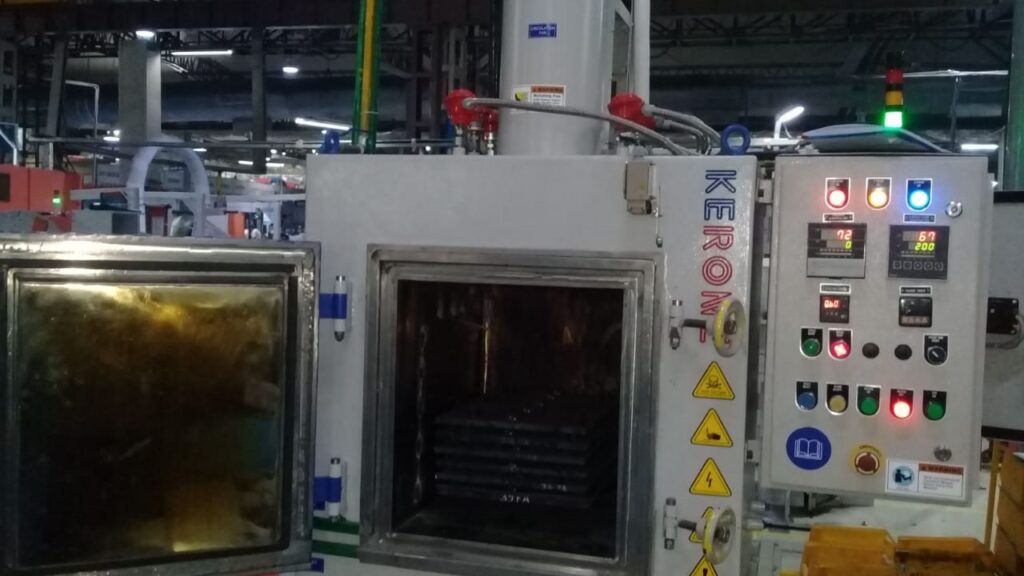Curing is a chemical process employed in polymer chemistry and process engineering that produces the toughening or hardening of a polymer material by cross-linking of polymer chains. Even if it is strongly associated with the production of thermosetting polymers, the term curing can be used for all the processes where starting from a liquid solution, a solid product is obtained.
During the curing process, single monomers and oligomers, mixed with or without a curing agent, react to form a tridimensional polymeric network.
In the initial part of the reaction branches molecules with numerous architectures are formed, and their molecular weight will increase in time with the extent of the reaction till the network size is up to the size of the system. The system has lost its solubility and its viscosity tends to infinite. The remaining molecules begin to be with the macroscopic network till they react with the network creating different crosslinks. The crosslink density will increase until the system reaches the end of the chemical reaction.
Curing can be initiated by heat, radiation, electron beams, or chemical additives. To quote from IUPAC: curing “might or might not require mixing with a chemical curing agent.
“Thus, two broad classes are
- Curing induced by chemical additives (also called curing agents, hardeners).
- Curing in the absence of additives. An intermediate case involves a mixture of resin and additives that requires external stimulus (light, heat, radiation) to induce curing.
The curing methodology depends on the resin and the application. Particular attention is paid to the shrinkage induced by the curing. Usually small values of shrinkage (2-3%) are desirable.
Curing induced by additives
Epoxy resins are typically cured by the use of additives, often called hardeners. Polyamines are often used. The amine group’s ring-open the epoxide rings.
In rubber, the curing is also induced by the addition of a cross linker. The resulting method is termed Sulfur vulcanization. Sulfur breaks down to form polysulfide cross-links (bridges) between sections of the polymer chains. The degree of crosslinking determines the rigidity and durability, similarly as different properties of the material.
Paints and varnishes usually contain oil drying agents; metal soaps that catalyse cross-linking of the unsaturated oils of which they’re largely comprised. As such, once paint is described as drying it’s infact hardening. Oxygen atoms serve the crosslinks, analogous to the role played by sulfur within the vulcanization of rubber.
Curing without additives
In the case of concrete, curing entails the formation of silicate crosslinks. The process is not induced by additives.
In several cases, the resin is provided as a solution or mixture with a thermally-activated catalyst, that induces crosslinking but solely upon heating. for example, some acrylate-based resins are formulated with dibenzoyl peroxide. Upon heating the mixture, the peroxide converts to a free radical, which adds to an acrylate, initiating crosslinking.
Some organic resins are cured with heat. As heat is applied, the viciousness of the resin drops before the onset of crosslinking, whereupon it will increase because the constituent oligomers interconnect. This method continues till a tridimensional network of oligomer chains is formed – this stage is termed gelation. In terms of processability of the resin this marks a very important stage: before gelation the system is relatively mobile, after it the quality is incredibly limited, the micro-structure of the resin and also the composite material is fixed and severe diffusion limitations to further cure are created. Thus, in order to achieve vitrification in the resin, it’s typically necessary to increase the process temperature after gelation.
When catalysts are activated by ultraviolet radiation, the process is called UV cure.
Different Monitoring Methods:
- Rheological analysis
- Thermal analysis
- Dielectrometric analysis
- Spectroscopic analysis
- Ultrasonic analysis
We at KERONE have a team of experts to help you with your need for Curing in various products range from our wide experience.

